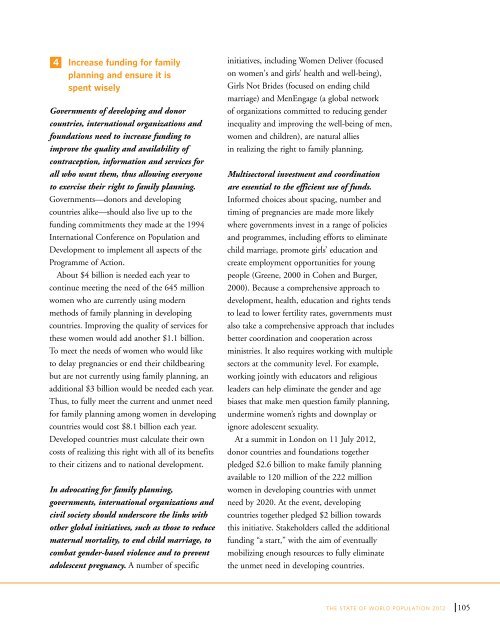State of World Population 2012 - Country Page List - UNFPA
State of World Population 2012 - Country Page List - UNFPA
State of World Population 2012 - Country Page List - UNFPA
Create successful ePaper yourself
Turn your PDF publications into a flip-book with our unique Google optimized e-Paper software.
4 Increase funding for family<br />
planning and ensure it is<br />
spent wisely<br />
Governments <strong>of</strong> developing and donor<br />
countries, international organizations and<br />
foundations need to increase funding to<br />
improve the quality and availability <strong>of</strong><br />
contraception, information and services for<br />
all who want them, thus allowing everyone<br />
to exercise their right to family planning.<br />
Governments—donors and developing<br />
countries alike—should also live up to the<br />
funding commitments they made at the 1994<br />
International Conference on <strong>Population</strong> and<br />
Development to implement all aspects <strong>of</strong> the<br />
Programme <strong>of</strong> Action.<br />
About $4 billion is needed each year to<br />
continue meeting the need <strong>of</strong> the 645 million<br />
women who are currently using modern<br />
methods <strong>of</strong> family planning in developing<br />
countries. Improving the quality <strong>of</strong> services for<br />
these women would add another $1.1 billion.<br />
To meet the needs <strong>of</strong> women who would like<br />
to delay pregnancies or end their childbearing<br />
but are not currently using family planning, an<br />
additional $3 billion would be needed each year.<br />
Thus, to fully meet the current and unmet need<br />
for family planning among women in developing<br />
countries would cost $8.1 billion each year.<br />
Developed countries must calculate their own<br />
costs <strong>of</strong> realizing this right with all <strong>of</strong> its benefits<br />
to their citizens and to national development.<br />
In advocating for family planning,<br />
governments, international organizations and<br />
civil society should underscore the links with<br />
other global initiatives, such as those to reduce<br />
maternal mortality, to end child marriage, to<br />
combat gender-based violence and to prevent<br />
adolescent pregnancy. A number <strong>of</strong> specific<br />
initiatives, including Women Deliver (focused<br />
on women's and girls’ health and well-being),<br />
Girls Not Brides (focused on ending child<br />
marriage) and MenEngage (a global network<br />
<strong>of</strong> organizations committed to reducing gender<br />
inequality and improving the well-being <strong>of</strong> men,<br />
women and children), are natural allies<br />
in realizing the right to family planning.<br />
Multisectoral investment and coordination<br />
are essential to the efficient use <strong>of</strong> funds.<br />
Informed choices about spacing, number and<br />
timing <strong>of</strong> pregnancies are made more likely<br />
where governments invest in a range <strong>of</strong> policies<br />
and programmes, including efforts to eliminate<br />
child marriage, promote girls’ education and<br />
create employment opportunities for young<br />
people (Greene, 2000 in Cohen and Burger,<br />
2000). Because a comprehensive approach to<br />
development, health, education and rights tends<br />
to lead to lower fertility rates, governments must<br />
also take a comprehensive approach that includes<br />
better coordination and cooperation across<br />
ministries. It also requires working with multiple<br />
sectors at the community level. For example,<br />
working jointly with educators and religious<br />
leaders can help eliminate the gender and age<br />
biases that make men question family planning,<br />
undermine women’s rights and downplay or<br />
ignore adolescent sexuality.<br />
At a summit in London on 11 July <strong>2012</strong>,<br />
donor countries and foundations together<br />
pledged $2.6 billion to make family planning<br />
available to 120 million <strong>of</strong> the 222 million<br />
women in developing countries with unmet<br />
need by 2020. At the event, developing<br />
countries together pledged $2 billion towards<br />
this initiative. Stakeholders called the additional<br />
funding “a start,” with the aim <strong>of</strong> eventually<br />
mobilizing enough resources to fully eliminate<br />
the unmet need in developing countries.<br />
THE STATE OF WORLD POPULATION <strong>2012</strong><br />
105
















